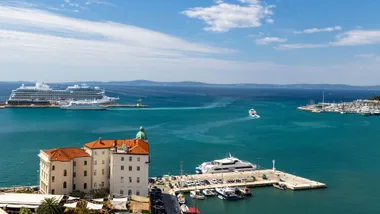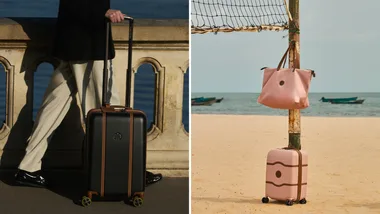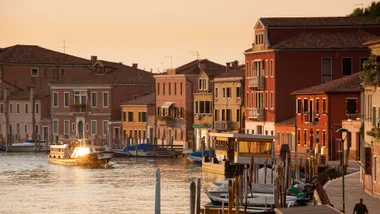An apple a day: Tasmania’s cider trail
Getting there
Jetstar, Qantas and Virgin Australia all fly direct into Launceston and Hobart airports from Melbourne, Sydney, Brisbane and the Gold Coast, with additional connections via Melbourne.
DOWN SOUTH
David Bennett’s ciders are mostly sold at festivals such as Taste Festival in Hobart, but tastings and sales are available from the cider shed by appointment. 16 Waterworth Dr, Margate, 0419 309 589
Red Sails Cider
Visits by appointment; highly recommended if you are a lover of full-flavoured traditional European cider styles. Ciders are also available through various outlets around Tasmania (such as A Common Ground, right). 100 Esplanade Rd, Middleton, (03) 6292 1685
Cellar door sales from Puddleduck Vineyard in the Coal River Valley. 992 Richmond Rd, Richmond, (03) 6260 2301
Visits by appointment. Currently, ad hoc tastings are conducted in the cidery itself but there are plans to build a proper cellar door at the orchard. 22 Lollara Rd, Grove, (03) 6266 4339
At the time of writing, a cider bar and café was being constructed in a renovated church hall in Franklin to sell ciders from the Clark family’s old Huon Valley orchard. Slated to open late 2013.
The brewery’s Farm Bar is open every Friday and Sunday except in June. A dedicated bus service ($15 return) runs from Hobart on those days. 2862 Lyell Hwy, Hayes, (03) 6261 1930
Cascade Brewery Visitor’s Centre
This popular Hobart tourist attraction focuses mainly on beer, of course, but as the historic Mercury cider is also produced at Cascade, the displays includes memorabilia from Tasmania’s cider-making past. 140 Cascade Rd, South Hobart, (03) 6224 1117
The Abbey Cider Lounge
Late last year the owners of the popular Preachers pub restaurant in Battery Point took over the Mayfair Tavern in Sandy Bay and reopened it as The Abbey, with six mostly local ciders on tap and dozens of ciders stocked in the bottle shop. 236 Sandy Bay Rd, Sandy Bay, (03) 6251 1758
Lark Distillery Shop and Tasting Bar
If you’re popping in to buy some of Lark’s excellent, rich, heady cider brandy, I strongly suggest you also stay for the full whisky tasting – it’s a revelation. 14 Davey St, Hobart, (03) 6231 9088
This provisions store at Salamanca, joint-owned by Gourmet Farmer‘s Matthew Evans and cheesemaker Nick Haddow, stocks artisan Tasmanian cider including Red Sails and Two Metre Tall. Shop 3, 77 Salamanca Pl, Hobart, 0429 370 192
UP NORTH
It’s not just cider at this comfortable local cider bar: Dickens also pours top local drops such as Nant and Lark whiskies. Plans are afoot to open another Dickens Cider House in Hobart, and in Montpelier Retreat, Salamanca. 63a Brisbane St, Launceston, (03) 6334 8915
Try these good winemaker-crafted ciders at the comfortable and welcoming cellar door at Holm Oak Vineyard. 11 West Bay Rd, Rowella, (03) 6394 7577
A brand-new cider cellar door selling a good range of modern-style Australian ciders produced from local orchards. 6 Melrose Rd, Spreyton, (03) 6427 3664
Give yourself plenty of time to try John Cole’s superb spirits and liqueurs as well as his authentic English-style still cider. 407 Back Rd, Wilmot, (03) 6492 1193
As well as a good sparkling cider, Willie Simpson also produces exceptional beers. 22 Crockers St,Railton, (03) 6496 1139
Wonderful, atmospheric early colonial estate with a remarkable, mid-19th century stone cider mill and wooden beam press among its many attractions. Woolmers La, Longford, (03) 6391 2230
It’s almost closing time when I get to Woolmers, the 200-year-old colonial homestead and farm just outside Launceston, Tasmania. Late-summer shadows creep across the lawn towards one of Australia’s oldest cider houses – a weatherboard barn built in the 1840s.
Entering the gloom of the barn feels like stepping back in time to the Old Country – into an ancient cider shed in deepest, darkest Somerset, perhaps.
I’ve come to see the traditional stone cider mill here, a huge carved circular sandstone trough containing one massive stone wheel. And suddenly I imagine a draught horse plodding endlessly around the trough, rolling the heavy wheel as men tip sacks of apples into its relentless pulping path.
This is history few mainlanders know. Most think the Australian cider boom is only six or seven years old. But our cider-making heritage stretches back far beyond that. Cider from Woolmers slaked the thirst of diggers at Ballarat in the 1860s and Hobart’s own Mercury cider was first made in 1911.
Cider’s popularity has ebbed and flowed ever since: all the rage in the ’70s, out of favour in the ’90s. Now, in 2013, Tasmania – Australia, in fact – is in the middle of another cider craze. New producers are popping up all over the place: winemakers and brewers are fermenting apples and pears; and veteran orchardists are diversifying into the resurgent cider market.
Best of all, many of these cider-makers are located in gorgeous parts of Tasmania – from the D’Entrecasteaux Channel in the south to Cradle Mountain in the north – making a cider-themed tour a particularly enjoyable way to see the island.
David Bennett is one of the two or three Tasmanian cider-makers who kept the flame alive in the ’90s and early 2000s, which is why I start my journey at his cider shed in Margate, in the channel country south of Hobart. I get a good feel here for the grunt involved in crushing and pressing apples as Bennett, who trained as a boilermaker, shows off his 34-tonne press – a marvel of solid iron hydraulic engineering that looks like it was wrenched from the bowels of an ocean liner.
I begin to get a good feel, too, of the cider history bubbling just under the surface of the present. Bennett talks about his insistence on using an old English apple, the Sturmer Pippin, for his cider; about how, despite its long history in Tasmania as a cooking, canning and cider variety, the Sturmer is endangered in orchards today thanks to the supermarkets’ insistence on modern, bland apples such as Fuji and Gala.
It’s not the last time I hear about or taste good cider made from Sturmers.
As I drive further south down the Channel Highway, the low shadow of Bruny Island glides across the flat water to my left. I pass old, laden apple trees in wet paddocks, red jewels hanging from lichen-covered boughs. Clive Crossley and Lynne Uptin’s Red Sails orchard is tucked on a hillside running up from the channel at Middleton. The centre of this idyllic property is an 1880s whaler’s cottage with a splendid 100-year-old pear tree in the garden.
Crossley – another of the cider faithful – takes me on a tour of the orchard he has slowly planted during the past two decades: proper English cider apples with colourful names such as Yarlington Mill and Tremlett’s Bitter.
“I was born on the slopes of Glastonbury Tor,” says Dr Crossley, with the trace of a West Country accent. “Yarlington was a few miles away from where I grew up.”
I bite into a red, round Somerset Redstreak and taste with a jolt how different cider apples are from the sweet, juicy dessert varieties. The astringency grabs your tongue, making your eyes water. It’s precisely this astringency, though, that makes Crossley’s cider taste so reminiscent of the deep-golden, full-flavoured dry ciders of England’s West Country.
For Australians, conditioned by the ubiquity of mass-produced brands to cider being pale, sweet, carbonated lolly water, these traditional characters can be initially challenging but ultimately rewarding.
“The funny thing is,” says Crossley, “we set up a little stall at the Wooden Boat Festival in Hobart in February, and our wild-yeast-fermented cider – the most traditional and extreme in flavour – was the runaway favourite.”
After leaving Red Sails I loop through Cygnet and back up into the Huon Valley, an historic apple-growing region home to some big expanses of orchard.
Next stop is Grove Heritage Nursery (not normally open to the public) for a walk with cider-maker Mark Robertson through the remarkable collection of hundreds of different apple, pear and quince trees. Robertson has been manager at Grove for the past couple of years but has recently left to start selling his new brand of cider, Lost Pippin, through the Puddleduck cellar door in the Coal River Valley,
over on the other side of Hobart.
As we wander through the rows of cider-apple trees, Robertson talks about old Tasmanian-bred varieties such as Crofton, Democrat and Geeveston Fanny – varieties that may, one day, offer cider producers like him delicious flavour options, as long as orchardists are prepared to replant these out-of-favour cultivars. “If Tassie can be known as the Apple Isle again through what’s in the bottle, then that’s super,” says Robertson.
Currently, most Tasmanian cider-makers are using whatever they have to hand to keep up with the demand of thirsty cider drinkers. In father-and-son team Ian and Andrew Smith’s case, “whatever’s to hand” means eating apples from the family’s 55-hectare Huon Valley certified organic orchard next door to Grove.
The Smiths have been growing apples since the 1880s. Since late 2012, they’ve been producing cider onsite and selling it under the Willie Smith’s label. Until a proper cellar door is built, visitors can taste and buy goods in the cidery, surrounded by the bustle of a working apple-packing shed.
In these early stages of production, the Smiths have been trialling different techniques of cider-making in an effort to introduce some complexity into the drink. Not all the techniques are equally successful, but it’s a fascinating experience tasting cider out of old whiskey or old port barrels.
Day two of my cider trek and it’s a cracking blue morning at the Two Metre Tall Farm Bar in the Derwent Valley. We’re not in apple country any more: up here to the north-west of Hobart, sun-bleached hillsides form the backdrop to Ashley and Jane Huntington’s brewery and cidery.
Ashley isn’t afraid to upset conventional brewing wisdom and do things other brewers would be scared to do: fermenting beer “wild” with airborne yeasts (rather than adding cultured yeasts) for example, and deliberately embracing sourness in his brews. It makes for illuminating, highly entertaining conversation as we taste the ciders and beers on offer, including a true oyster stout – fermented with 60 kilograms of live unshucked oysters – and dip into the coolroom to taste an experimental, gorgeous fermenting perry (the name for a cider-like drink made from pears).
Ashley is another big fan of the Sturmer Pippin apple, and uses it in his cider. “Our big limitation as Australian cider makers is that most of us can only use dessert apples,” he says. “It’s like making wine with sultana grapes rather than proper wine grapes like shiraz or chardonnay. But what you get with a Sturmer is a minerality, a tartness. You get some real cider character in your cider.”
Later that day, I manage to negotiate Launceston’s one-way system to find the Dickens Cider House, a narrow, comfortable bar full of regulars, students and apple memorabilia, including furniture made from old picking bins, posters and photographs from Tasmania’s apple exporting glory days. Exactly the kind of place in which you want to sit and drink cider and yarn. Over a pint of his cloudy “Old English” (made from Fuji apples and given roughness and grunt with the judicious addition of hops), co-owner John Dickens tells me his story.
Dickens was born in the UK but moved to a converted apple shed in the picturesque Tamar Valley in 2008 where he became friends with local winemaker Corey Baker. “We were sitting around one night having a few wines,” says Dickens, “and Corey said, ‘You’re living in an old apple shed on an old orchard and your name’s Dickens. You have to make cider’. So we had another glass of red and registered the business name that same night.”
Next morning, I wind my way up to the top of the Tamar Valley, past vineyards and villages, to the rolling farming country where Bec and Tim Duffy have planted 120 cider apple trees next to their chardonnay and pinot noir vines at Holm Oak vineyard.
Bec and Tim started making cider under the Small Players label in 2009 from whatever apples were around. But when they made a batch using Sturmers they had gathered from an small old orchard, they realised what a difference it made.
When Bec pours me a glass of the 2012 Sturmer Pippin cider, I can see why this inspired them to plant more real cider varieties: with its golden colour, deep bruised-apple aroma and chewy texture, it’s one of the best Australian ciders I’ve ever tried.
Then it’s time to head west, through Devonport, past round red hills blanketed with leafy crops, into the country towards Cradle Mountain, with jagged contours and beautiful, plunging landscapes around every next corner.
The gleaming new Spreyton cidery and cellar door is a joint venture between the local Langworthy and Viney orcharding families with 90 hectares of dessert apples at their disposal. It’s been open for barely a year, but already a regional cider tradition has emerged. Cider-maker Damien Viney takes me through the range on tap in the cellar door, including the Bright cider made using Jonagold and Granny Smiths, and the Dark cider made with an addition of hops.
“We have locals coming in now and asking for an ‘Overcast’,” grins Viney.
“Half Bright and half Dark.” He pours me one to demonstrate the blend and it tastes very good.
Further on up into the high country I feel the land rise. Forests crowd the road. There are snatches of clear space around bends. And then, suddenly, looking out towards Cradle Mountain, a lovely wide expanse with wild apple trees clinging to the fringes of a horse paddock.
I arrive at John and Ruth Cole’s Wilmot Hills orchard to find the couple in overalls and gumboots, shovelling freshly milled apple pulp into a basket press, which is dribbling golden juice.
This place is about as close to the ideal of the small cidery as it’s possible for anyone to imagine: tree-sheltered wooden buildings housing the mill, the press and a small still, all of which John (a trained engineer) built himself. The Coles’ orchard is full of traditional varieties including Yarlington Mill, Bulmer’s Norman, Sweet Coppin, and Improved Foxwhelp, all planted by John in 1994, “back when no one wanted cider”.
John moved here from Melbourne in the late ’80s because he wanted to live near the mountain, and, while he’d planted vines, he didn’t want to plant apples. “A bloke in the next valley was trying to encourage people to plant cider trees, even though you couldn’t sell a bottle of cider back then.
Of course, I said no. But I had a dream – and this is true – I had a dream: I woke up and said, ‘All right, I will’. So I planted a cider orchard.”
After a few years of making cider and selling it to the few people who were then interested, in 2006 John also started distilling some of his cider and turning it into apple brandy. He cheekily insists on calling it “Calvados”, using the French name when he knows full well it only legally applies to apple brandy made in France. But it’s this superb apple brandy of which he is most proud. As good as his cider is – very traditional, very dry – it’s still more reminiscent of an apple wine than a cider.
“I never thought I’d be a brandy drinker,” John says, eyes twinkling. “But I just love it. I’d be happy to have ‘Calvados maker’ written on my gravestone.”
Dusk falls, and I have one more stop on the way back to Launceston. Railton is a small town south of Devonport famous for its topiary and the Seven Sheds craft brewery, owned by beer writer Willie Simpson and his partner Catherine Stark.
The Seven Sheds hop garden and tasting room attracts a steady stream of beer lovers and it’s easy to see why. Brews such as the Willie Warmer dark ale and Smokin’ Bagpipes whiskey cask-aged ale are among Australia’s best. But I’m here for the rustic sparkling cider, which Simpson buys from John at Wilmot Hills as dry, still cider and then bottle-conditions it by adding a little yeast and sugar to produce a gentle fizz.
“Like John, I just want to make things I want to drink,” says Simpson. “I think that might be a good definition of being an artisan producer.”

 Adrian Lander
Adrian Lander









